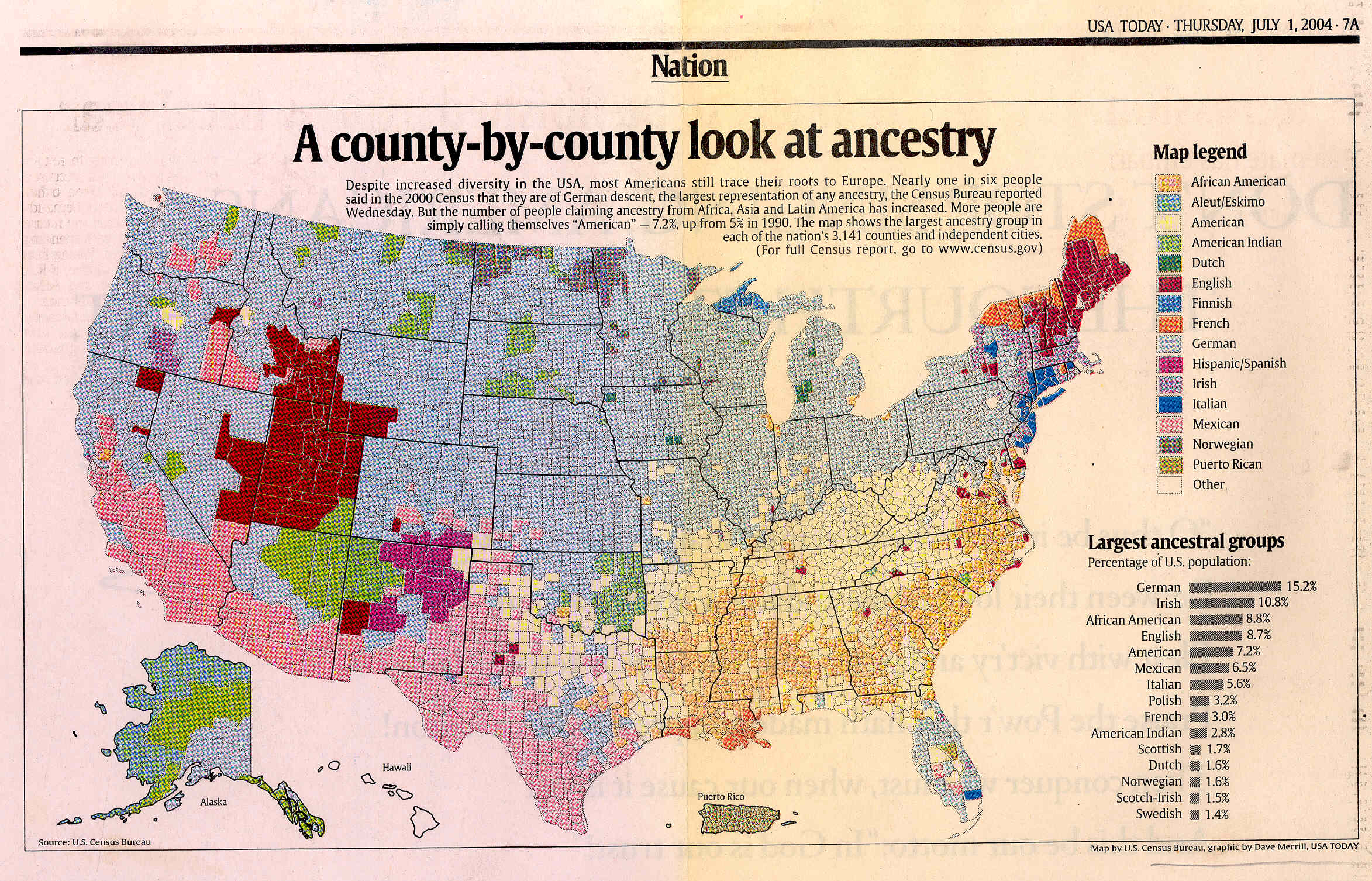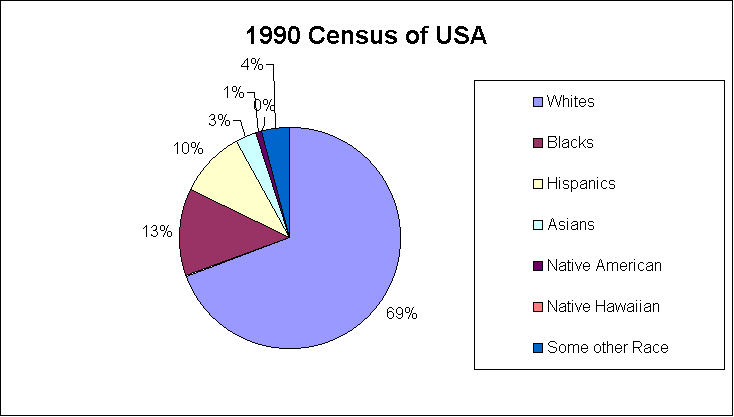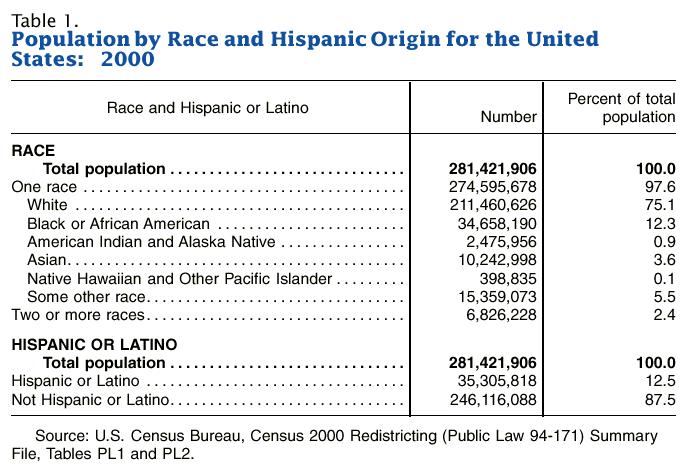Internal
Links
Top
|
|
Outline on Race
& Ethnicity
|
|
External
Links
|
| |
RACE IS A SOCIAL CATEGORY THAT CANNOT BE DEMONSTRATED BY PHYSICAL
SCIENCE |
|
| |
It is impossible to locate any 'pure' races of people in that the mixture
w/in each broad category defies classification in that 'racial characteristics'
vary w/in race as much as across race |
|
| |
Biologists have mapped the complete DNA of humans & comparing thousands
of living humans all over the world shows that the DNA of 'racial' categories
are more often more similar than the DNA w/in these 'racial' categories |
|
| |
For example East Indians have dark skin & Euro facial features |
|
| |
India is extremely diverse & w/ over 1 bb people & there
are Indians whose complexions are from white to black |
|
| |
Racial theory has been all but discredited but anthropologists who
studied the East Indians stated that Indians fit into the Caucasian category |
|
| |
East Indians consider themselves white because race is not solely based
on skin color, it also has to do w/ bone structure, hair type, height,
etc |
|
| |
The Indians hold a resemblance to Europeans in their features, and
a lot of Mediterranean countries have India as their source population |
|
| |
The Oxford Dictionary defines Caucasian as relating to a broad division
of humankind covering peoples from Europe, western Asia, & parts
of India & North Africa |
|
| |
Racial classification is inexact & science shows that it is an
obsolete & inaccurate concept; the cultures of the world have yet to
understand that the Human Race is what ALL people belong to |
|
| |
RACE IS A CATEGORY THAT THE PHYSICAL SCIENCES HAVE FAILED TO FIND
TO EXIST |
|
| |
A race is a group of people who share socially recognized
physical characteristic(s), a social or cultural heritage (typically
ancestry or religion) & recognize themselves as a distinct status
group |
|
| |
A race is a socially constructed category composed of people who share
biologically transmitted traits that members of a society consider important |
|
| |
Race is a significant concept because most people regard it as very
important |
|
| |
WI Thomas said 'situations defined as real are real in their consequences,'
& so it is w/ race |
|
| |
Race is a social category rather than a biological category & thus
racial differences are only important because: |
|
| |
a. people have defined them as important & acted upon these
socially defined definitions |
|
| |
b. cultural & sub cultural differences are often associated
w/ race due to the long term separation of grps w/ socially defined racial
differences |
|
| |
ETHNICITY IS THE RECOGNITION BY SOCIAL GRPS THAT CULTURAL
VARIATION MAY DEFINE A CATEGORY OF PEOPLE |
|
| |
People frequently confuse the terms race & ethnicity & use
them interchangeably, but they are not the same |
|
| |
An ethnic group is a group of people who share a socially
recognized social or cultural heritage ( typically ancestry
or religion ) & recognize themselves as a distinct status group |
|
| |
An ethnic group is a category of people who are recognized as
a distinct status group entirely on the basis of social or cultural criteria,
such as nationality or religion, but cannot be recognized by their physical
appearance alone |
|
| |
An ethnic grp refers to a grp that is relatively distinct in cultural
backgrd compared w/ dominant grps in the society |
|
| |
Ethnicity is a shared cultural heritage |
|
| |
Ethnicity involves even more variability & mixture than race because
most people identify w/ more than one ethnic background |
|
| |
Examples of ethnic groups include gypsies, Jews, Italians, southerners,
etc. |
|
| |
Our conception of race is a form of social differentiation: race is
much more a socially defined trait, than a genetic
one |
|
| |
Racial & ethnic groups are socially defined categories of people
who share a common ascribed status |
|
| |
Membership in racial & ethnic groups is generally hereditary |
|
|
|
There is no reliable way to identify a person's ethnic group by his
or her physical appearance |
|
| |
Many separate ethnic grps may be considered racially identical; for
example, Euros are similar in socially defined racial characteristics,
yet they represent diverse cultural grps & among Americans are ethnic
grps such as Polish American, German Americans, Japanese Americans, &
so on |
|
| |
MAJORITY / MINORITY LABELS REFER TO THE POWER A GRP
EXHIBITS, NOT POPULATION NUMBERS |
|
| |
Those in the disadvantaged or subordinate positions in a society are
called the minority group |
|
| |
A minority is a category of people, distinguished by physical or cultural
traits, who are socially disadvantaged |
|
| |
Minorities have two important characteristics: a distinct identity
& subordination |
|
| |
Not all members of a minority category are disadvantaged |
|
|
|
Those in the advantaged or dominant positions in a society are called
the majority group |
|
|
|
In considering the definition of minority & majority groups, note
that a numerical minority can be a majority the sociological sense |
|
| |
A minority is any category of people, characterized by physical or
cultural differences, that a society sets apart & subordinates |
|
| |
While women fit the definition of a minority group, most white women
do not think of themselves in this way |
|
| |
A numerical majority of people can be "the minority" if they are subordinated
& therefore the beliefs of the various grps in society is important
in determining majority / minority status |
|
| |
Minority women are doubly disadvantaged, as explained by intersection
theory, the investigation of the interplay of race, class, & gender,
often resulting in multiple dimensions of disadvantage |
|
|
|
The underclass includes poor people who are chronically unemployed
or underemployed & who lack the necessary skills to obtain stable,
quality employment |
|
| |
In the US, minority usually refers to blacks, Hispanics, Asians, Native
Americans & other non-white ethnic groups |
|
| |
The term white ethnics has meaning because whites share a socially
recognized social or cultural heritage & recognized themselves as a
distinct status group |
|
| |
Whites have a long history of ethnic conflict as recently seen in the
form Yugoslavia, btwn Irish & English, & historically btwn English,
French, & Germans which are all different ethnic groups |
|
| |
MOST SOCIAL & PHYSICAL SCIENTISTS CATEGORIZE PEOPLE INTO 9 RACES |
|
| |
Humans share 97 % of the same genes w/ chimpanzees & the other
2 % of our genetic code largely defines non-racial differentiation (weight,
height, etc.) & thus less than 1% of our genetic code defines race |
|
| |
Number of races: Most experts now recognize nine
races |
|
| |
Most of humanity has their origins in the THREE ancestral root races
- Negroid who are primarily African Asian
- Mongoloid who are primarily Asian Oceania
- Caucasoid who are primarily European Asian
along w/ SIX others, including the
- Aborigines of Australia
- Micronesians of the Yap Islands
- Negritos of the Philippines
- Australian
- Melanesian
- Polynesian |
|
| |
Race came into being as a social category when 19th C biologists tried
to construct racial types |
|
|
|
Some of the names of the races come from early examinations of race
which wrongly held that their origins were near the areas of Mongolia in
east central Asia, Nigeria in Africa near the west central horn of Africa,
& the Caucasus Mountains in central Eurasia |
|
| |
Social scientists consider terms like Caucasoid, Negroid, & Mongoloid
as misleading at best because there are no biologically pure races &
because the names come from regions wrongly believed to be the cradle of
that race |
|
| |
THE ORIGIN OF RACES IS IN |
|
|
|
There are TWO theories of racial origins, but there is little clear
scientific understanding of why, where, & how races originated |
|
|
|
1. Dispersion theory holds that we all have one ancient
ancestor in Africa & that species dispersed throughout world &
as it did, people changed & races emerged |
|
|
|
2. Isolation theory holds that people did not originate
only in Africa but all over the world (except No & So Am --to where
people migrated) & thus similar beings, people emerged in relative
isolation but w/ similar characteristics except for race |
|
| |
DNA mapping demonstrates the folly of the category of race & the
existence of our common origins in Africa |
|
| |
DNA mapping has also shown that all humans originated in Africa |
|
| |
About 50 K yrs ago homo sapiens began moving out of Africa, going north
& east, w/ one grp arriving in what is now Australia some 46 K yrs
ago |
|
| |
After several thousand yrs, there were superficial changes among these
humans in things like skin color to adapt to new climates around the world |
|
|
|
THE SOCIAL CONSTRUCTION OF RACE |
|
| |
Obach points out that the idea that race is socially constructed is
widely accepted w/in social science disciplines |
|
| |
Because people tend to view their world as an objective reality divorced,
in many ways, from interpretation or constructed meaning, we often don't
see race, or we ignore race as much as we can |
|
| |
It is difficult overcome the idea that nature determines race &
to comprehend the principle of the social construction of race because
the processes of the social construction of any identity, whether it be
racial, gender, class, age, etc. are so subtle & pervasive |
|




